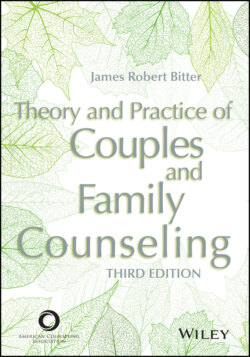Читать книгу Theory and Practice of Couples and Family Counseling - James Robert Bitter - Страница 17
An Overview of the Book
ОглавлениеFamily counseling was initiated in the early part of the 20th century, but it was in the latter half of that century that the practice of working with families really came into its own. That is when the masters of family theory and practice—Nathan Ackerman, Gregory Bateson, Murray Bowen, Oscar Christensen, Rudolf Dreikurs, Richard Fisch, Jay Haley, Lynn Hoffman, Don Jackson, Cloe Madanes, Monica Mc-Goldrick, Salvador Minuchin, Virginia Satir, David and Jill Scharff, Mara Selvini Palazzoli, Paul Watzlawick, John Weakland, and Carl Whitaker—developed ideas and models that would serve as the foundation for the family practice professions. After some 60 years of substantial growth and development, the field began to incorporate the postmodern, social constructionist positions of Tom Andersen, Harlene Anderson, Insoo Kim Berg, Steve de Shazer, David Epston, Kenneth Gergen, Harold Goolishian, William O’Hanlon, Michele Weiner-Davis, and Michael White. Race, culture, gender, and family life cycle development are now central considerations and assessments in family counseling.
From the last decade of the 20th century to the present, couples counseling has emerged as a distinct discipline in its own right. Although each of the family models has adapted its approach to working with couples, three new models currently dominate the field. These models, developed by John and Julie Gottman (the sound relationship house model), Susan M. Johnson (emotionally focused therapy with couples), and Harville Hendrix and Helen Hunt (imago therapy), are all based on the neuroscience that supports and confirms attachment theory (see Porges, 2017). The models fall in the realm of evidence-based practice, and given their prominence, they are addressed in separate chapters in this book.
Couples and family practitioners come in many different forms and represent similar, if distinct, orientations. There are the marriage and family therapists who receive their training in programs that are now largely autonomous and accredited by the Commission on Accreditation for Marriage and Family Therapy Education, the accrediting body of the American Association for Marriage and Family Therapy. There are couples, marriage, and family counselors who receive their training in counselor education programs, sometimes accredited by the Council for Accreditation of Counseling and Related Educational Programs, and who belong to the International Association of Marriage and Family Counselors, a division of the American Counseling Association. Clinical family practitioners are also trained in schools of social work. And both psychiatry and psychology now have divisions devoted to family practice.
In general, those who are associated with the American Association for Marriage and Family Therapy and family practice in psychiatry and psychology tend to focus on psychopathology—both how it is maintained and what effects it has on family systems. Those associated with the International Association of Marriage and Family Counselors and counseling programs in general tend to focus more on family growth and development, resource identification, and what is now considered resiliency practice (J. B. Simon et al., 2005). Here the emphasis is on normalizing family process, activating ignored or denied individual and family skills and abilities, and focusing on what works and avenues to desired solutions. To be sure, these are not dichotomous positions, and many family approaches are embraced by both orientations (see Carlson et al., 2005; Sperry et al., 2019).
The theory chapters in this book have a relatively consistent format to aid you in comparing and contrasting the various approaches. Each chapter begins with a short introduction that introduces the founders and major contributors to the theory as well as its main emphasis. This introduction is followed by dialogue from an actual counseling session conducted by one of the main contributors to the model. Within the presentation of this counseling session, I ask you to consider certain questions that relate to understanding the model, its application, and how it relates to your own values and beliefs about helping others and family practice. A section that highlights key concepts of the model follows the counseling session; here the heart of the theory is presented for your consideration. Somewhat shorter sections on counseling goals and the practitioner’s role and function follow so that an emphasis is placed on the purpose and the person of the counselor. The section on process and interventions is designed to provide you with the process, skills, and interventions most associated with the theory. In this section, I address how to use the model with couples and/or families. This section is followed by an application of the model to the fictitious Quests as a couple or a family. A full description of the Quest family is presented at the beginning of Part 2. Again, the purpose of presenting the Quest family is to allow you to compare and contrast the different theories in actual practice. Each theory chapter ends with a summary of the approach; gender and cultural contributions associated with practitioners of the model; and a list of suggested readings, DVDs, and references. Although the word “counselor” is used throughout this text, it is intended to include all family practitioners from the fields of counseling, marriage and family therapy, psychiatry, psychiatric nursing, psychology, and social work.
